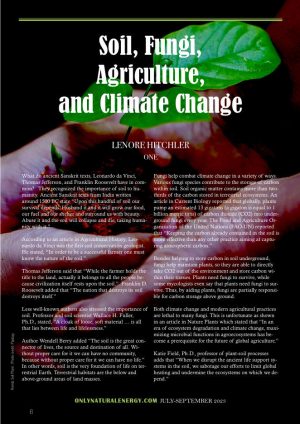 What do ancient Sanskrit texts, Leonardo da Vinci, Thomas Jefferson, and Franklin Roosevelt have in common? They recognized the importance of soil to humanity. Ancient Sanskrit texts from India written around 1500 BC state “Upon this handful of soil our survival depends. Husband it and it will grow our food, our fuel and our shelter and surround us with beauty. Abuse it and the soil will collapse and die, taking humanity with it.”
What do ancient Sanskrit texts, Leonardo da Vinci, Thomas Jefferson, and Franklin Roosevelt have in common? They recognized the importance of soil to humanity. Ancient Sanskrit texts from India written around 1500 BC state “Upon this handful of soil our survival depends. Husband it and it will grow our food, our fuel and our shelter and surround us with beauty. Abuse it and the soil will collapse and die, taking humanity with it.”
According to an article in Agricultural History, Leonardo da Vinci was the first soil conservation geologist. He stated, “In order to be a successful farmer one must know the nature of the soil.”
Thomas Jefferson said that “While the farmer holds the title to the land, actually it belongs to all the people because civilization itself rests upon the soil.” Franklin D. Roosevelt added that “The nation that destroys its soil destroys itself.”
Less well-known authors also stressed the importance of soil. Professor and soil scientist Wallace H. Fuller, Ph.D., stated, “A cloak of loose, soft material … is all that lies between life and lifelessness.”
Author Wendell Berry added “The soil is the great connector of lives, the source and destination of all. Without proper care for it we can have no community, because without proper care for it we can have no life.” In other words, soil is the very foundation of life on terrestrial Earth. Terrestrial habitats are the below and above-ground areas of land masses.
Fungi help combat climate change in a variety of ways. Various fungi species contribute to the storage of carbon within soil. Soil organic matter contains more than two-thirds of the carbon stored in terrestrial ecosystems. An article in Current Biology reported that globally, plants pump an estimated 13 gigatons (a gigaton is equal to 1 billion metric tons) of carbon dioxide (CO2) into underground fungi every year. The Food and Agriculture Organization of the United Nations (FAO-UN) reported that “Keeping the carbon already contained in the soil is more effective than any other practice aiming at capturing atmospheric carbon.”
Besides helping to store carbon in soil underground, fungi help maintain plants, so they are able to directly take CO2 out of the environment and store carbon within their tissues. Plants need fungi to survive, while some mycologists even say that plants need fungi to survive. Thus, by aiding plants, fungi are partially responsible for carbon storage above ground.
Both climate change and modern agricultural practices are lethal to many fungi. This is unfortunate as shown in an article in Nature Plants which stated that “In an era of ecosystem degradation and climate change, maximizing microbial functions in agroecosystems has become a prerequisite for the future of global agriculture.”
Katie Field, Ph.D., professor of plant-soil processes adds that “When we disrupt the ancient life support systems in the soil, we sabotage our efforts to limit global heating and undermine the ecosystems on which we depend.”
Fungi, the plural form of fungus, is a separate biological kingdom, just as plants and animals are each separate kingdoms. The fungal kingdom includes mushrooms, molds, mildews, and yeast plus the fungi found inside plants, both in and on plant roots, and in the soil.
Some species of fungi damage human health, and certain mushrooms are even fatal when ingested. Various molds and mildews are extremely destructive to health and property. Other fungal species can either severely damage or kill forests or food crops.
Despite various species of fungi being detrimental to humans, fungi are part of the circle of life. For example, biological decomposers maintain life on the planet. Without them, old plant and animal remains would pile up and there would eventually be no room for new life. There are various types of decomposers, and fungi are just one out of many. Unfortunately, decomposition releases CO2. Luckily, decomposition releases nutrients used by plants that in turn store CO2. Eventually, these plants die, and the cycle continues.
Statistics about fungi are awesome. The latest estimation is that the total number of terrestrial fungal species is between six to eight million. Fungi have existed on the planet for millions of years. Estimates of how-long fungi-plant symbiosis has existed varies. Symbiosis refers to a mutually beneficial relationship between different species.
According to an article in Current Biology, fungi-plant symbiosis has existed for more than 400 million years. In contrast, according to recent genetic research published in Science, land fungi evolved around 1,300 million years ago, and land plants evolved around 700 million years ago. Fungi gradually created the right environment to enable the survival of plants on land. Dr. Field stated that in biological weathering, fungal hyphae secrete organic acids that dissolve rocks and therefore make nutrients available to plants.
In due course, plants moved from the seas to land and then survived because of the development of fungi-plant symbiotic relationships. In turn, land plants provide food for animals, either directly by herbivores, or indirectly by carnivores. Thus, fungi hold an extremely necessary and valuable position in the global food chain. Merlin Sheldrake, Ph.D., an expert on mycorrhizal networks, went so far as to say that “Plant’s relationships with mycorrhizal fungi underpin much of life on land.”
The amount and extent of soil fungi are incredible. Sheldrake stated that in just one teaspoon of soil, there may be enough fungal mycelium to span approximately 6.2 miles. Mycelium is a network of fungal threads. The FAO-UN reported that there are more organisms in one tablespoon of healthy soil than the total human population of the planet. According to Paul Stamets, who has studied fungi for decades, every ounce of soil contains thousands of species of fungi. It is estimated that 25% of Earth’s species live underground, and fungi are a major part of this ecological niche.
Soil contains 80% of the carbon found in terrestrial ecosystems, according to an article in Nature Education Knowledge. “Soil organic matter is composed of soil microbes including bacteria and fungi, decaying material from once-living organisms such as plant and animal tissues, fecal material, and products formed from their decomposition.”
Fungal mycorrhizal networks contribute to the production of soil organic matter.
Arbuscular mycorrhizal fungi produce glomalin. An arbuscular mycorrhiza is a type of mycorrhiza in which fungi penetrate the root cells of a vascular plant. According to the United States Department of Agriculture [USDA], glomalin is an arbuscular-mycorrhizal fungal soil protein. Michael Amaranthus, Ph.D., retired USDA research soil scientist, discussed the importance of glomalin in fighting climate change. He stated that “Glomalin may account for as much as one-third of the world’s soil carbon and the soil contains more carbon than all plants and the atmosphere combined.”
According to the USDA, glomalin “forms clumps of soil granules called aggregates. These add structure to soil and keep other stored soil carbon from escaping.” Sara Wright, Ph.D., soil scientist at the USDA, stated, “Glomalin levels are maintained or raised by no-till, cover crops, reduced phosphorus inputs, and the sparing use of crops that don’t have arbuscular mycorrhizal fungi associated with their roots.”
Modern agricultural methods contribute to climate change by causing stored carbon in the soil to be released into the atmosphere. An article in PNAS (Proceedings of the National Academy of Science) estimated the total global loss of carbon from soil in the last 12,000 years of agriculture. The figure was 133 billion metric tons of carbon for the top 6.56 feet of soil, with the rate of loss increasing dramatically in the past 200 years. Dr. Fayaz Malla, assistant professor of environmental science adds that “In the first decade of the 21st century, soil degradation released between 3.3 and 3.6 billion tonnes of CO2 into the atmosphere.”
More discussion regarding the loss of carbon stored in soil was published by the Yale School of the Environment. The article reported that “According to Rattan Lal, director of the Ohio State University’s Carbon Management and Sequestration Center, the world’s cultivated soils have lost between 50 and 70 percent of their original carbon stock, much of which has oxidized upon exposure to air to become CO2. … Lal says that restoring soils of degraded and desert ecosystems has the potential to store in world soils an additional 1 to 3 billion tons of carbon annually.”
Further information on the effects of modern agriculture on soil and fungi was published by Communications Biology. The article reported that “AMF [arbuscular mycorrhizal fungi] diversity was lower in cereal-producing farmland soils than in grassland soils.
Other studies observed similar reductions in microbial and fungal diversity in the soils of other agricultural systems, such as vineyards, orchards, and arable crops. … Most modern crop plants have not been bred with this symbiotic relationship with AMF in mind, and thus are only inefficiently colonized by AMF.” A study reported in Science Daily reported “By altering the plants that grow across much of the Earth’s surface from those with strong soil carbon storage to weak carbon storage we have potentially further contributed to increased atmospheric CO2.”
Thus, modern agriculture damages the very fungi that produce soil. Fortunately, there are better alternatives such as increasing biodiversity. Miranda Hart, professor of biology at the University of British Columbia, Canada stated, “The single most important thing you can do is encourage biodiversity on your farm. With more plants, you get more different kinds of fungi, and these fungi bring with them different benefits.” Also, use no-till methods because plowing breaks down connections in the fungal network, reducing soil’s ability to store carbon. Cover crops should be planted because bare land results in diminished fungal growth.
Mycorrhizal fungi networks make nitrogen and phosphorus available to plants and in return receive energy in the form of carbon (carbohydrates).
According to an article in the Journal of Environmental Quality, nitrogen fertilizers have caused a net loss of native soil organic carbon. If plants are given a surplus of nitrogen, they stop relying on their fungal networks. This contributes to another negative circle in which the plants need more nitrogen fertilizers, leading to more climate change because fossil fuels are used in the production and distribution of fertilizer.
Using phosphorus fertilizers also disturbs plant-fungi symbiosis. Wendy Taheri, Ph.D. in ecology and evolutionary biology stated, “When we saturate the soil with plant-available phosphate, plants reject their symbiotic partners.” An article in Nature Ecology and Evolution added “The use of fungicides and subsequent decline in arbuscular mycorrhizal fungi richness in croplands reduced phosphorus uptake by 43%.”
Besides storing carbon, fungal networks also aid plants to resist pests. According to Scientific Reports, “There is increasing evidence that mycorrhizal networks can transmit herbivore-or pathogen-induced defense signaling compounds to warn neighbors of pest infestations.” For example, an article in Ecology Letters reported an experiment that showed that warning messages from plants infested with aphids were sent through a mycelium fungus network to plants not yet afflicted. Loss of these types of fungi from climate change and agricultural methods will lead to using more pesticides. This will lead to further fungal death leading to even greater use of pesticides and then more climate change.
Climate change frequently leads to either excessive precipitation or extreme lack of precipitation. Fortunately, fungal filaments help plants deal with droughts by stretching deep into the soil, gathering water and nutrients from a volume 100 times greater than the roots could reach on their own, according to an article published at the University of Texas.
Besides droughts, soil salinity is another environmental hazard. Soil salinity is caused by several factors. For example, irrigation inevitably leads to the salinization of soil according to an article published by the University of Minnesota’s Institute on the Environment. Globally, 33% of irrigated land and over 20% of cultivated land contains soil that has become excessively saline. Also, rising sea levels on low-lying coasts due to climate change may lead to saltwater inundating the area, thus contaminating the soil, and increasing salinity.
Increased soil salinity stresses plants. An article in Plant and Soil reported that “Salt stress hinders photosynthesis resulting in an enormous loss in crop productivity.” Luckily, some mycorrhizal fungi species increase their host plant’s tolerance of salt. An article in Frontiers in Plant Science explains this by stating “Symbiotic fungi can modulate gene expression of the host plant to modify its phenotype to improve the tolerance to abiotic stress factors caused by soil salinity.”
Soil salinity reduces the amount of soil organic carbon according to an article in Environmental Science & Technology. Lower levels of carbon stored in soil result in higher levels of CO2 in the atmosphere and will therefore increase climate change.
Climate change makes the planet an unhealthy environment for humanity with rising temperatures, droughts, and crop failures. Climate change, fungi, and soil are intertwined together like strands of DNA. What negatively affects one will harm the other two.
Likewise, what benefits one will also benefit the others. Since fungi help to combat climate change, it is necessary to employ agricultural methods that help soil fungi thrive. An added benefit of doing so is that less fossil fuels will be deployed, thus slowing down the greenhouse effect, and this will help combat climate change creating a healthier environment. Healthier fungi lead to healthier soil that leads to healthy plants, people, and a healthier planet.
Lenore Hitchler





